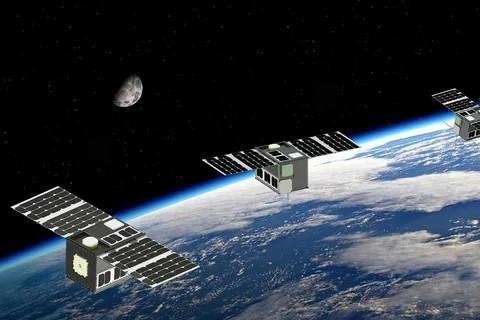The global small satellite market is poised for significant expansion, projected to grow from USD 6,654.7 million in 2025 to USD 21,950.8 million by 2035, demonstrating an impressive Compound Annual Growth Rate (CAGR) of 12.7%. This robust growth is primarily fueled by continuous advancements in satellite technology, the widespread expansion of communication networks, and a surging demand for Earth observation data across various sectors. Military, communication, and scientific industries are increasingly turning to small satellites to improve global connectivity and enable data-driven decision-making.
Exhaustive Market Report: A Complete Study
https://www.futuremarketinsights.com/reports/small-satellite-market
The Rise of Compact and Versatile Spacecraft
Small satellites, encompassing CubeSats, nanosatellites, microsatellites, and minisatellites, are engineered for rapid deployment, modularity, and cost-effective operations. These compact spacecraft integrate cutting-edge sensors, onboard artificial intelligence (AI), advanced propulsion systems, and high-speed data transmission capabilities. Operating predominantly in Low Earth Orbit (LEO) and Medium Earth Orbit (MEO), they offer diverse applications across telecommunications, Earth observation, defense, and scientific research.
In telecommunications, small satellites are instrumental in providing broadband communications, supporting IoT initiatives, and enhancing 5G backhaul operations. Earth observation satellites deliver high-resolution imagery crucial for disaster monitoring, climate studies, and agricultural analysis. For defense, small satellites serve vital roles in surveillance, intelligence gathering, and navigation support missions. They are also increasingly utilized for deep space missions and technology demonstration, with the rising integration of AI and machine learning for satellite data processing further solidifying their integral role in modern aerospace and commercial space endeavors.
Market Dynamics: Innovation Meets Investment
The small satellite market is experiencing significant growth driven by a trend of numerous private players and startups forging partnerships with established space agencies. The adoption of large satellite constellations, particularly in LEO, is on the rise to ensure seamless global connectivity and remote sensing capabilities. Continuous advancements in propulsion systems, artificial intelligence, and modular satellite architectures are further improving operational efficiency.
Despite challenges such as orbital congestion and complex regulatory concerns, innovative solutions focused on space sustainability, including active debris removal and satellite servicing, are actively being pursued. Emerging economies are also making substantial investments in small satellite programs, diversifying the competitive landscape. Further improvements in launch technologies and the proliferation of “satellite-as-a-service” business models are expected to accelerate market expansion.
Examining semi-annual market trends, the CAGR for the global small satellite market is projected to be 12.7% for H1 2024 (January to June) and 13.1% for H2 2024 (July to December), both spanning the 2024-2034 decade. Looking into 2025-2035, the CAGR for H1 2025 is expected to be 12.2%, with H2 2025 showing a higher growth at 13.3%.
Segmental Growth and Regional Leadership
The increasing use of minisatellites in commercial and scientific applications is enhancing market growth, offering advanced capabilities for various missions. These satellites, typically weighing between 100 to 500 kg, provide high-resolution imaging and data collection at lower costs. NASA’s Small Satellite Launch Initiative aims to facilitate 200 small satellite launches by 2025, reflecting significant investment.
Microsatellites are vital for enhancing communication networks and technology demonstration, with their compact size and cost-effectiveness making them ideal for frequent updates and rapid deployment. The USA Department of Defense Space Force has funded a program to support 50 microsatellite launches over the next five years with a USD 500 million investment. Picosatellites are also gaining traction due to their cost-effectiveness and versatility for low-budget space experimentation, with the European Space Agency (ESA) launching a “Picosatellite Exploration Program” with EUR 160 million in funding over three years.
In terms of orbit type, Low Earth Orbit (LEO) satellites command the largest market share at 79.6% in 2025, primarily due to their widespread adoption in advanced space-based applications such as Earth observation and communication. LEO’s proximity to Earth enables high-resolution imaging and faster data transmission, crucial for environmental monitoring, disaster management, and global internet coverage.
Geographically, China is set to experience the highest CAGR of 17.3% from 2025 to 2035, driven by rising geopolitical tensions and advancements in satellite technology enhancing military intelligence and surveillance capabilities. India follows with a 16.1% CAGR, propelled by the demand for seamless connectivity and digital infrastructure modernization. Germany (10.9%) is seeing growth from space research initiatives, while Australia & New Zealand (13.7%) and the United States (12.6%) also show steady expansion.
Competitive Landscape: Innovation and Collaboration Drive Progress
The small satellite market is highly competitive, characterized by vendors relentlessly focusing on innovation, strategic partnerships, and expanding technological capabilities. Market leaders prioritize investments in advanced satellite technologies to meet the rising demand for Earth observation, communication, and scientific research. Companies are striving to differentiate themselves through cost-effective solutions, rapid deployment capabilities, and enhanced satellite performance. The emphasis on global connectivity and real-time data collection is propelling firms to innovate in satellite design and launch strategies.
Tier 1 vendors, including Lockheed Martin Corporation, Northrop Grumman Corporation, Airbus S.A.S., Boeing, and SpaceX, hold a dominant market share, offering end-to-end solutions from manufacturing to launch services and ground station operations. They possess advanced technological expertise and the capacity to manage large-scale satellite programs for government agencies, defense organizations, and major commercial entities.
Tier 2 vendors, such as OHB SE, Thales Alenia Space, and Israel Aerospace Industries Ltd., are medium-sized companies with solid market presence and specialized expertise in niche applications like Earth observation, communication, or scientific research. They focus on innovation and adapt quickly to emerging technologies. Tier 3 vendors, including NanoAvionics, GomSpace, and Blue Canyon Technologies, are smaller and emerging players, often specializing in specific components, software, or subsystems, and catering to emerging markets.
Recent industry updates highlight this dynamic environment. In January 2024, Airbus acquired Eutelsat’s 50% share in the OneWeb Satellites joint venture, signaling evolving satellite constellation projects. SpaceX launched 76 satellites across three Falcon 9 rockets in March 2024, demonstrating rapid deployment capabilities. Lockheed Martin emphasized high-rate delivery and streamlined processing for small satellites in August 2023, while OHB Sweden AB and Space Norway collaborated to launch the microsatellite ADIS in June 2023. These developments underscore the continuous drive for technological advancement and strategic partnerships shaping the future of the small satellite market.
Get Ahead with Our Report: Request Your Sample Now!
https://www.futuremarketinsights.com/reports/sample/rep-gb-3298
Discover trends shaping similar markets-read our related reports.
Small Satellite Market Share Analysis
https://www.futuremarketinsights.com/reports/small-satellite-market-share-analysis
Small Molecule API Market
https://www.futuremarketinsights.com/reports/small-molecule-api-market
Small-Molecule Injectable Market
https://www.futuremarketinsights.com/reports/small-molecule-injectable-market
Future Market Insights Inc.
Christiana Corporate, 200 Continental Drive,
Suite 401, Newark, Delaware – 19713, USA
T: +1-845-579-5705
For Sales Enquiries: sales@futuremarketinsights.com
Website: https://www.futuremarketinsights.com
Future Market Insights, Inc. (ESOMAR certified, recipient of the Stevie Award, and a member of the Greater New York Chamber of Commerce) offers profound insights into the driving factors that are boosting demand in the market. FMI stands as the leading global provider of market intelligence, advisory services, consulting, and events for the Packaging, Food and Beverage, Consumer Technology, Healthcare, Industrial, and Chemicals markets. With a vast team of 400 analysts worldwide, FMI provides global, regional, and local expertise on diverse domains and industry trends across more than 110 countries.
This release was published on openPR.



















